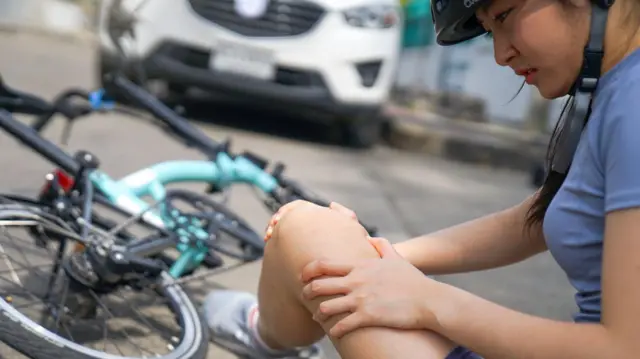“The innate joy of riding a bicycle is unmatched” – former US President John F. Kennedy’s quote is popular on the Internet. Whether or not he really says it, cycling is considered one of the easiest ways to keep the body and mind in shape.
Even in Bangladesh, it is difficult to find a person who has not been introduced to a bicycle as a child. With the passage of time, the bicycle has now become a body and environment friendly vehicle. A two-wheeler will also save you time in Dhaka’s traffic jams.
According to the World Economic Forum, there are more than two billion bicycles in use worldwide. By the year 2050, the number can reach 5 billion or 5 billion.
In other words, the use of bicycles as a means of livelihood, transportation or sports is increasing day by day.
And all these have health benefits. As cycling reduces various physical and mental health risks, it also strengthens the body’s muscles and increases endurance.
But at what age one should start cycling, how long cycling is beneficial for health, what are the risks of cycling, let’s find some answers to these questions.
When is the bike?

IMAGE SOURCE,GETTY IMAGES
Surely many people remember asking the family to buy a bicycle as a child? But exactly what age is suitable to start cycling, there is no answer in that sense.
According to Harvard University School of Public Health, cycling can be done at any age. The same is said on the Australian Government’s website Better Health Channel, that people of all ages can get involved in cycling.
“It has no specific age,” says Ironman and triathlete Mohammad Samchuzzaman Arafat of Bangladesh.
He added, “My child is now five years old, and can ride a bicycle since four years. In my experience, everyone can actually ride a bike from four to as many years as possible.”
In this case, children can be started with tricycles or three-wheeled bicycles.

IMAGE SOURCE,GETTY IMAGES
However, various statistics show that children who attend special primary schools have a higher rate of bicycle accidents.
According to an estimate from the US Centers for Disease Control and Prevention, men between the ages of 55 and 69 are more likely to die in bicycle accidents. Therefore, special precautions are emphasized in this case.
Generally speaking, people can ride a bicycle from a minimum of 4 years to a maximum of 70 or more years in some cases.
Bicycles are healthy
It has been said that if cycling were a drug, doctors would prescribe it to everyone.
Let’s look at just one statistic on the health side of cycling: “Those who cycle to work have a 41% reduction in the risk of any type of death,” according to a study by the University of Edinburgh and Glasgow in Scotland.
The study was conducted on cyclists aged 16 to 74 years from 2011 for the next 5 years. The study found that depression among cyclists decreased in 2016 compared to 2011.
In other words, cycling removes physical diseases as well as mental diseases.

The Australian government’s website Better Health Channel says cycling can prevent serious diseases such as stroke, heart attack, some types of cancer, depression, diabetes, obesity and arthritis.
Dr Jason Gill, a researcher at the University of Glasgow, told the BBC: “It’s now proven that any form of exercise is associated with health risks. The benefits of cycling to work in particular are undeniable.”
He said, riding a bicycle creates a habit. You don’t have to fight with your mind.
And of all the physical exercises, cycling is the cheapest, fun and easy to include in the daily routine.
Unlike other sports it doesn’t require much skill, most people know how to ride a bike, and the best part is that once you learn to ride a bike, you never forget it.

IMAGE SOURCE,GETTY IMAGES
“From a young age we actually developed an interest in bicycles,” said Mr. Arafat. “Balancing on two wheels is great, refreshes your body and mind,” he said.
How cycling benefits the body:
* Reduces the risk of heart disease by strengthening the lungs
* Strengthens various muscles of the body and makes the body sensitive
* Reduces stress
* Strengthens bones
* Reduces body fat and inflammation
A study by the University of Edinburgh and Glasgow found that regular cycling reduced the risk of heart disease by 46 per cent and cancer by 45 per cent. In addition, the risk of developing dementia is reduced by 20 to 28 percent.
According to British Cycling, the UK’s guardian of cycle sports, a brisk cycle can burn up to 500 calories an hour, which keeps you healthy and in control of your weight.
How long to ride a bike?

IMAGE SOURCE,GETTY IMAGES
Various statistics and studies show that people who cycle regularly feel 10 years younger.
But exactly how many times a day cycling is good for health?
The Better Health Channel says 2 to 4 hours of cycling per week is enough for normal fitness. The risk of injury is very low.
Same goes for Arafat, a regular cycling trainer.
“For your health or fitness you can cycle for half an hour a day for 3 hours a week. And if you want to spend a little more time, 1 hour a day, 6 hours a week.”
The British Heart Foundation also recommends 30 minutes of cycling per day to maintain fitness.
Where are the dangers of cycling?
“Every year in the United States, 1,000 bicyclists die in crashes with other vehicles, and another 130,000 are injured on the roads” – statistics from the US Centers for Disease Control and Prevention.
Accident rates are naturally higher among the elderly and children. And most of this happens in urban areas where the pressure from other vehicles is very high. And the issue of excessive speed has come up as the cause of the accident.

IMAGE SOURCE,GETTY IMAGES
“Usually there is danger of accidents on the road,” Mohammad Arafat said, “In this case, it is important to have a helmet, gloves, signal lights, if these safety precautions are followed, accidents can be avoided.”
“I’ve had accidents myself but having these has reduced the damage.”
According to the Better Health Channel, cycling injuries are usually caused by excessive stress on the body and improper sitting posture.
According to them, only 7% of total injuries involve other vehicles. And most of the time you will either fall and hurt yourself or hit something on the road. This can also be reduced by following the rules of the road.
Their advice in this regard is:
*Giving indication light or hand signal while turning
* Obey road signals
* Wearing bright clothes to be easily noticed by other vehicles
*Avoid headphones while cycling
* Getting the bicycle serviced at least once every year
Besides, those who have back pain are advised to practice cycling while sitting upright.

IMAGE SOURCE,MOHAMMAD SHAMSUZZAMAN ARAFAT
To all this Mohammad Arafat added, “It is better not to cycle for those who have knee or hand injuries. Again, even with asthma, cycling is risky.” He said to follow the doctor’s advice in these cases.
And of course water should be kept with the cyclists, so that the body can avoid dehydration by drinking water at regular intervals.
Claire Hyde of Cancer Research UK, Britain’s top private cancer research organisation, says – “The more active people are in their daily lives, the lower their risk of disease. “You don’t have to go to the gym every day, you don’t have to run a marathon.. spend some time in your daily life doing activities that increase the speed of your breathing.”